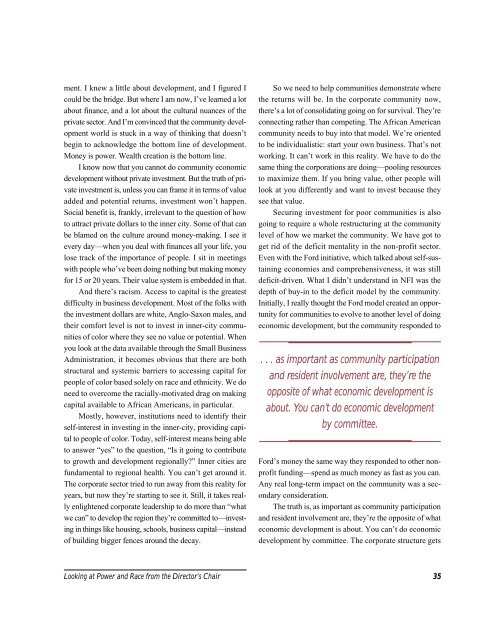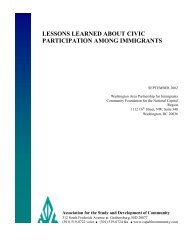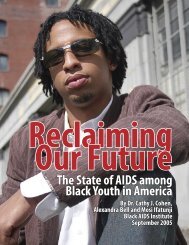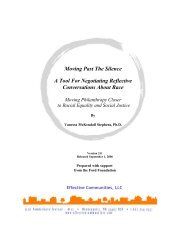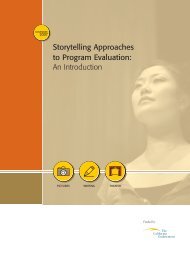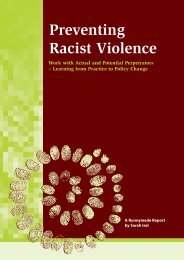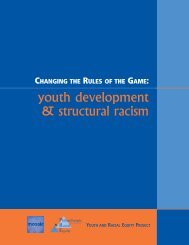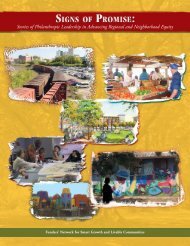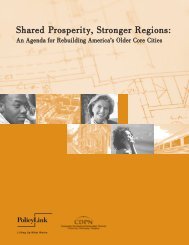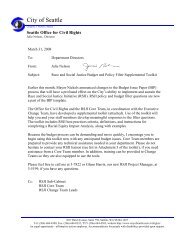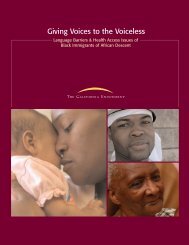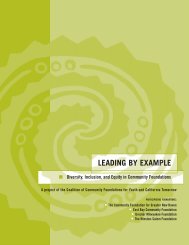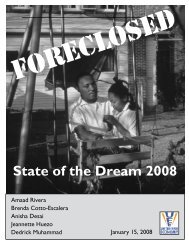Core Issues in Comprehensive Community-Building Initiatives ...
Core Issues in Comprehensive Community-Building Initiatives ...
Core Issues in Comprehensive Community-Building Initiatives ...
Create successful ePaper yourself
Turn your PDF publications into a flip-book with our unique Google optimized e-Paper software.
ment. I knew a little about development, and I figured I<br />
could be the bridge. But where I am now, I’ve learned a lot<br />
about f<strong>in</strong>ance, and a lot about the cultural nuances of the<br />
private sector. And I’m conv<strong>in</strong>ced that the community development<br />
world is stuck <strong>in</strong> a way of th<strong>in</strong>k<strong>in</strong>g that doesn’t<br />
beg<strong>in</strong> to acknowledge the bottom l<strong>in</strong>e of development.<br />
Money is power. Wealth creation is the bottom l<strong>in</strong>e.<br />
I know now that you cannot do community economic<br />
development without private <strong>in</strong>vestment. But the truth of private<br />
<strong>in</strong>vestment is, unless you can frame it <strong>in</strong> terms of value<br />
added and potential returns, <strong>in</strong>vestment won’t happen.<br />
Social benefit is, frankly, irrelevant to the question of how<br />
to attract private dollars to the <strong>in</strong>ner city. Some of that can<br />
be blamed on the culture around money-mak<strong>in</strong>g. I see it<br />
every day—when you deal with f<strong>in</strong>ances all your life, you<br />
lose track of the importance of people. I sit <strong>in</strong> meet<strong>in</strong>gs<br />
with people who’ve been do<strong>in</strong>g noth<strong>in</strong>g but mak<strong>in</strong>g money<br />
for 15 or 20 years. Their value system is embedded <strong>in</strong> that.<br />
And there’s racism. Access to capital is the greatest<br />
difficulty <strong>in</strong> bus<strong>in</strong>ess development. Most of the folks with<br />
the <strong>in</strong>vestment dollars are white, Anglo-Saxon males, and<br />
their comfort level is not to <strong>in</strong>vest <strong>in</strong> <strong>in</strong>ner-city communities<br />
of color where they see no value or potential. When<br />
you look at the data available through the Small Bus<strong>in</strong>ess<br />
Adm<strong>in</strong>istration, it becomes obvious that there are both<br />
structural and systemic barriers to access<strong>in</strong>g capital for<br />
people of color based solely on race and ethnicity. We do<br />
need to overcome the racially-motivated drag on mak<strong>in</strong>g<br />
capital available to African Americans, <strong>in</strong> particular.<br />
Mostly, however, <strong>in</strong>stitutions need to identify their<br />
self-<strong>in</strong>terest <strong>in</strong> <strong>in</strong>vest<strong>in</strong>g <strong>in</strong> the <strong>in</strong>ner-city, provid<strong>in</strong>g capital<br />
to people of color. Today, self-<strong>in</strong>terest means be<strong>in</strong>g able<br />
to answer “yes” to the question, “Is it go<strong>in</strong>g to contribute<br />
to growth and development regionally?” Inner cities are<br />
fundamental to regional health. You can’t get around it.<br />
The corporate sector tried to run away from this reality for<br />
years, but now they’re start<strong>in</strong>g to see it. Still, it takes really<br />
enlightened corporate leadership to do more than “what<br />
we can” to develop the region they’re committed to—<strong>in</strong>vest<strong>in</strong>g<br />
<strong>in</strong> th<strong>in</strong>gs like hous<strong>in</strong>g, schools, bus<strong>in</strong>ess capital—<strong>in</strong>stead<br />
of build<strong>in</strong>g bigger fences around the decay.<br />
So we need to help communities demonstrate where<br />
the returns will be. In the corporate community now,<br />
there’s a lot of consolidat<strong>in</strong>g go<strong>in</strong>g on for survival. They’re<br />
connect<strong>in</strong>g rather than compet<strong>in</strong>g. The African American<br />
community needs to buy <strong>in</strong>to that model. We’re oriented<br />
to be <strong>in</strong>dividualistic: start your own bus<strong>in</strong>ess. That’s not<br />
work<strong>in</strong>g. It can’t work <strong>in</strong> this reality. We have to do the<br />
same th<strong>in</strong>g the corporations are do<strong>in</strong>g—pool<strong>in</strong>g resources<br />
to maximize them. If you br<strong>in</strong>g value, other people will<br />
look at you differently and want to <strong>in</strong>vest because they<br />
see that value.<br />
Secur<strong>in</strong>g <strong>in</strong>vestment for poor communities is also<br />
go<strong>in</strong>g to require a whole restructur<strong>in</strong>g at the community<br />
level of how we market the community. We have got to<br />
get rid of the deficit mentality <strong>in</strong> the non-profit sector.<br />
Even with the Ford <strong>in</strong>itiative, which talked about self-susta<strong>in</strong><strong>in</strong>g<br />
economies and comprehensiveness, it was still<br />
deficit-driven. What I didn’t understand <strong>in</strong> NFI was the<br />
depth of buy-<strong>in</strong> to the deficit model by the community.<br />
Initially, I really thought the Ford model created an opportunity<br />
for communities to evolve to another level of do<strong>in</strong>g<br />
economic development, but the community responded to<br />
. . . as important as community participation<br />
and resident <strong>in</strong>volvement are, they’re the<br />
opposite of what economic development is<br />
about. You can’t do economic development<br />
by committee.<br />
Ford’s money the same way they responded to other nonprofit<br />
fund<strong>in</strong>g—spend as much money as fast as you can.<br />
Any real long-term impact on the community was a secondary<br />
consideration.<br />
The truth is, as important as community participation<br />
and resident <strong>in</strong>volvement are, they’re the opposite of what<br />
economic development is about. You can’t do economic<br />
development by committee. The corporate structure gets<br />
Look<strong>in</strong>g at Power and Race from the Director’s Chair 35


